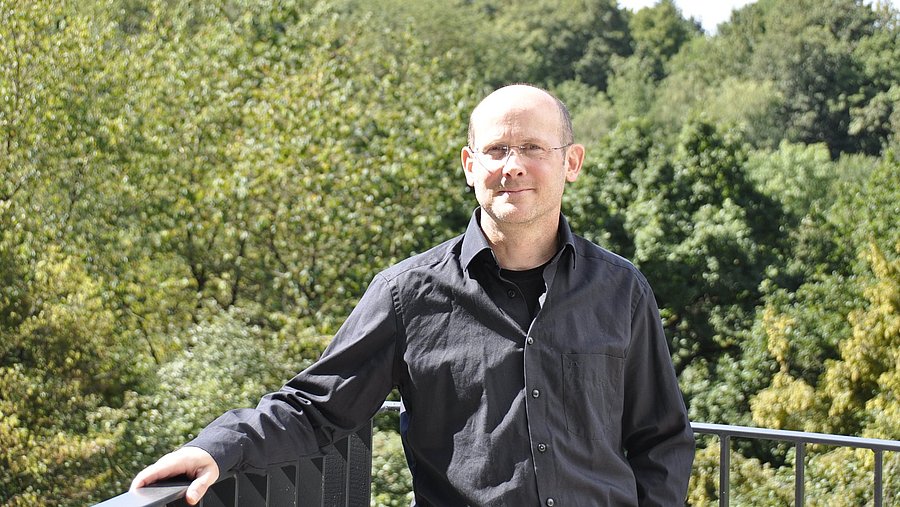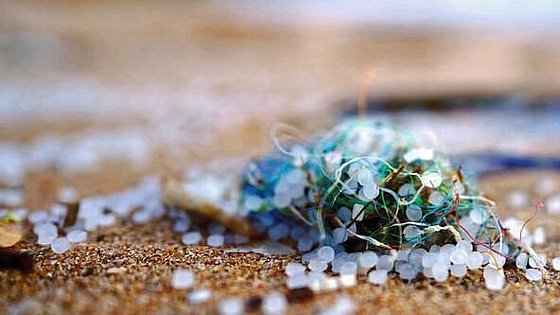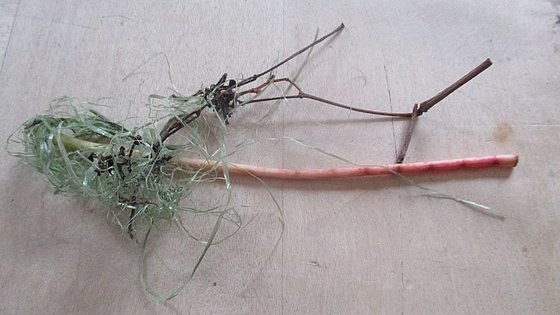
Microplastics
Dr. Marc Constapel / Management of chemical processes in industry
Photo: UniService Transfer
The gaps in our knowledge about microplastics are still enormous
Environmental chemist Marc Constapel on the still often unknown hazard potential of plastic particles.
According to the German Federal Institute for Risk Assessment (BfR), microplastics are plastic particles smaller than five millimeters and larger than one micrometer. When they enter the environment, they can usually no longer be removed. Microplastics enter our bodies with our food. There are estimates that we ingest up to 5 grams per week, the equivalent of about one check card. Where all this plastic comes from, where it is deposited, what dangers it poses to humans, animals and the environment, knows Dr. Marc Constapel, Research associate in the Management of Chemical Processes in Industry and Analytical Chemistry group at Bergische Universität. Different types of plastic and their additives
Not all plastics are the same, knows environmental chemist Marc Constapel, because they consist of different materials, such as polyethylene, polypropylene, polyvinyl chloride and polyamide. He says there are more than ten different types of plastic, which are both different in nature and contain different additives. "The microplastics also differ in form, meaning we find fibers, films, fragments, but also small beads that were already made that way in the first place," the expert explains. One of the often-discussed additives in plastics, he says, is flame retardants, which are found in almost all electrical appliances. "Plastics in cars and airplanes, they're all laced with flame retardants. We're talking millions of tons a year." Some of these flame retardants have since been banned because they have been shown to be problematic after years of use. This annoys the dedicated scientist especially because there are test methods that are relatively inexpensive and can provide results after only a short period of time to prove whether a substance is persistent (long-lived), toxic or bioaccumulative. "Instead, we put chemicals into the environment in larger quantities for years, which then have to be recalled." In the meantime, however, the situation has improved in this regard with the EU chemicals regulation REACH.
Plastic decomposes over the course of 400 years
Microplastics are largely formed from larger so-called macroplastics. Therefore, microplastics must be considered in the context of the plastics problem. "I discuss the plastic bag cycle with my students at the beginning of the lecture to understand the environmental problem holistically," Constapel explains. To do this, he draws a bag in the center of a sheet or the board and says, "The plastic bag doesn't fall from the sky. I have to look at where I get the raw materials for it, which is petroleum in most cases. That's where it starts." From raw material extraction to production, use, disposal and the social, legal as well as economic influences on the subject, the result is a comprehensive graphic that makes it clear to the students how complex the topic is. "Common plastics that enter the environment are thought to take about 400 years to decompose," he explains, continuing, "over time, as a result of sunlight or mechanical impact, among other things, it becomes brittle, fragile and fragments into smaller and smaller plastic particles." These particles are then found in soils, water and also in the air. They accumulate in plants and thus enter our food chain as well.
You have to think much further, he explains, because not only does the size of microplastic particles vary greatly, they also get smaller over time. You then get into the nanometer range. These particles are almost undetectable in environmental samples using current analytical methods. "We know a lot about microplastics at different levels, such as the amounts that enter the environment, where it occurs and partly how it affects ecosystems, but the gaps in our knowledge are still enormous."
Microplastics and our health
The German Federal Ministry for Risk Research currently says microplastics do not pose a health risk. "There's something to that," Constapel explains, "because the plastic is pretty inert (chemically inert, editor's note). A chemist would say it's a dead dog. But you have to take into account that it also often contains additives that we ingest insidiously." Microplastics are also a vehicle for other pollutants that accumulate on microplastics. "Very large amounts of microplastics are in house dust. If you look around your own four walls, you notice where there is plastic everywhere. Some of that gets rubbed off and crumbles into microplastics." One can imagine, he speculates, that if it gets into the human circulation and possibly settles on joints, it could also lead to inflammations through constant rubbing. However, there have been no publications on this so far. A research team recently found through experiments with mice that tiny plastic particles can penetrate tissues and organs and even enter the brain. "I find that alarming, if only for the reason that it doesn't belong there." Most importantly, the tiny particles (called nanoplastics) are cell-permeable; they can migrate to places in the body where particles normally can't go. Lukas Kenner, a pathologist at the Medical University of Vienna, says, "In the brain, plastic particles could increase the risk of inflammation, neurological disorders or even neurodegenerative diseases such as Alzheimer's or Parkinson's."

Microplastics in the sea: Photo: Sören Funk, public domain
Microplastics in the environment
Microplastics have not been known as an environmental problem for very long. A study covering the annual number of publications on microplastics and micropellets from 1970 to 2014 shows that scientific research on microplastics was published only very sporadically until 2007. "The scientific community simply didn't have the problem on its radar until then, even though it was there before. It wasn't until the scope of the problem was recognized that the number of publications also skyrocketed." But how much microplastic is actually in the environment now? "It is known that there are large 'plastic eddies' in the oceans," Constapel begins, "these are huge areas, some as big as Europe. There are circular ocean currents there where the plastic accumulates and circulates for decades. If you measure in these waters, you find plastic masses that are six times higher than the amount of plankton. That means you're changing ecosystems there. Completely new surfaces and transport vehicles are coming into play, and processes are taking place that were not there before. In the case of the fulmar, which spends most of its time above the open sea, a study found an average of more than 30 pieces of plastic in the stomachs of dead animals. This does not even include microplastics and nanoplastics. More than 200 animal species are known to mistake plastic for food. On coasts, microplastic levels of up to three percent are now found in the sand on some beaches."
It is unlikely that the amount of microplastics in the environment will decrease in the near future. There is too much macroplastic in the environment for that, and the annual global production volume of new plastic, which has increased exponentially over the past decades, is at a very high level.
Fertilizers - polluting nutrients for our soils.
"Fertilization is necessary," says the environmental chemist, "because the fields, which have been subject to intensive agriculture for decades, are totally depleted. There is hardly any organic matter left in the soil, and you can only achieve the high yields by fertilizing intensively and using various pesticides. It does the soil a lot of good when I apply sewage sludge. But the sewage sludge would have to be clean." But that's usually not the case, he says, so the sewage sludge has to be incinerated. And even if the limits for applying sewage sludge are met, significant amounts of microplastics end up in the fields with the sludge. Prof. Laforsch from the University of Bayreuth assumes that there will be no more arable land in Germany without microplastics in the soil. Therefore, it is not surprising that we even find tire abrasion particles in lettuce today. "Tire abrasion is actually cited as the largest source on land. But researchers believe if you ran street cleaning machines more often, you could collect about 80% of the microplastics. So just sweep."
Alternative hemp - a renewable resource with known potential
In the search for substitutes that could lead out of the unspeakable dilemma, Constapel points to the hemp plant, still often frowned upon today, as an alternative for synthetic fibers. Its benefits as a useful plant were already widely used in the Middle Ages. "Hemp is a wonderful material. The hemp fiber is much more tear-resistant than cotton, for example. I have also installed hemp in my own roof as an insulating material. It's very durable for a long time." But hemp cultivation in Germany is associated with high hurdles due to its intoxicating effect. This needs to be reconsidered, Constapel urges, because "it's a plant that's pretty undemanding. It is deeply rooted and therefore copes better with drought. Moreover, it contains biocides (biocides are used to kill or repel harmful organisms, editor's note) by itself, so it doesn't need to be sprayed. It also grows relatively quickly. It's a super renewable raw material that's not only interesting for the textile industry."

Remnant of a bird's nest, shredded floral tape becomes microplastic
Photo: CC BY-SA 4.0
Microplastics are a collective problem
Constapel's research focus in analytical chemistry includes the development of a method for analyzing microplastics. But can the findings of this research promote opportunities for rethinking the chemical industry in the wake of the sustainability debate? "I think this is a collective problem because of the enormous proliferation of plastics that also needs a collective approach," he explains. "We all need to pull together on this. My wish would be that this would be addressed collectively. We need to reinvent ourselves there." Analytics, however, already plays a key role in understanding the microplastics problem. But it is also, unfortunately, very challenging. "I've been doing analytics for more than 20 years and I can say that microplastics analytics is right up there in terms of difficulty. There are many scientists working on it, but it will certainly take a few more years before we have developed standardized, i.e. comparable, methods that are reasonably good at detecting microplastic levels in the environment. It will probably take even longer for the analysis of nanoplastics, if it is possible to establish a practicable routine analysis at all in the foreseeable future. However, we should not wait for that and take immediate measures that effectively reduce the input of further plastic or microplastics into the environment. Certainly, medium- and long-term strategies will also be needed to effectively reduce emissions to environmentally acceptable levels. Nature comes to our aid, as it has a great potential for self-healing. In the future, however, we must ensure that we do not exceed the limits of our exposure.
Education is the key
The problem of microplastics is omnipresent in the environment and can only be solved in the long term. In addition, microplastics are 'only' one of several serious environmental problems. However, the environment is nothing less than the basis of our lives, and we must treat it with care. So why not implement a subject in school as early as possible that teaches sustainable social skills. At the moment, this is perhaps more important for our existence on earth than one or two specialized lessons. We must collectively ensure that our environment remains in tact so that our children can still find a planet here on which they can live well.
Therefore, his final appeal is for all of us: "For me, it is important that these issues get the attention they deserve. Our attention is too often focused on consumption, and we tend to ignore environmental issues. For example, we don't immediately notice the loss of insects and wonder why we don't hear as many birds chirping as we used to. But it's all connected."
Uwe Blass
Dr. Marc Constapel is a research associate in the Management of Chemical Processes in Industry and Analytical Chemistry group.
